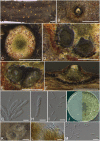Assessment of Cytospora Isolates From Conifer Cankers in China, With the Descriptions of Four New Cytospora Species
- PMID: 33679851
- PMCID: PMC7930227
- DOI: 10.3389/fpls.2021.636460
Assessment of Cytospora Isolates From Conifer Cankers in China, With the Descriptions of Four New Cytospora Species
Abstract
Cytospora species are widely distributed and often occur as endophytes, saprobes or phytopathogens. They primarily cause canker and dieback diseases of woody host plants, leading to the growth weakness or death of host plants, thereby causing significant economic and ecological losses. In order to reveal the diversity of Cytospora species associated with canker and dieback diseases of coniferous trees in China, we assessed 11 Cytospora spp. represented by 28 fungal strains from symptomatic branches or twigs of coniferous trees, i.e., Juniperus procumbens, J. przewalskii, Picea crassifolia, Pinus armandii, P. bungeana, Platycladus orientalis in China. Through morphological observations and multilocus phylogeny of ITS, LSU, act, rpb2, tef1-α, and tub2 gene sequences, we focused on four novel Cytospora species (C. albodisca, C. discostoma, C. donglingensis, and C. verrucosa) associated with Platycladus orientalis. This study represented the first attempt to clarify the taxonomy of Cytospora species associated with canker and dieback symptoms of coniferous trees in China.
Keywords: canker disease; coniferous trees; pathogen; phylogeny; taxonomy.
Copyright © 2021 Pan, Zhu, Tian, Huang and Fan.
Conflict of interest statement
The authors declare that the research was conducted in the absence of any commercial or financial relationships that could be construed as a potential conflict of interest.
Figures





References
-
- Adams G. C., Roux J., Wingfield M. J. (2006). Cytospora species (Ascomycota, Diaporthales, Valsaceae): introduced and native pathogens of trees in South Africa. Aust. Plant Pathol. 35, 521–548. 10.1071/AP06058 - DOI
-
- Adams G. C., Roux J., Wingfield M. J., Common R. (2005). Phylogenetic relationships and morphology of Cytospora species and related teleomorphs (Ascomycota, Diaporthales, Valsaceae) from Eucalyptus. Stud. Mycol. 52, 1–144.
-
- Alves A., Crous P. W., Correia A., Phillips A. (2008). Morphological and molecular data reveal cryptic speciation in Lasiodiplodia theobromae. Fungal Divers. 28, 1–13.
-
- Ariyawansa H. A., Hyde K. D., Jayasiri S. C., Buyck B., Chethana K. W. T., Dai D. Q., et al. (2015). Fungal diversity notes 111–252: taxonomic and phylogenetic contributions to fungal taxa. Fungal Divers. 75, 27–274. 10.1007/s13225-015-0346-5 - DOI
-
- Biggs A. R. (1989). Integrated control of Leucostoma canker of peach in Ontario. Plant Dis. 73, 869–874. 10.1094/PD-73-0869 - DOI
LinkOut - more resources
Full Text Sources
Other Literature Sources
Miscellaneous

